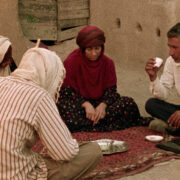The “Tiny Guy, Huge Girl” Trope Over the Years

Madeline Hrabik is a writer, film buff, and amateur historian…
There’s a media trope called the “Tiny Guy, Huge Girl” trope, which refers to a couple in which the woman is significantly taller than the man – think Boris and Natasha from The Rocky and Bullwinkle Show or Mike and Celia from Monsters, Inc. It’s most often used in a comedic manner, as a means of emasculating a man or exaggerating a woman’s dominance. Sometimes its goal is to ridicule the social deviance of a relationship in which the woman is taller; sometimes it’s to convey anxiety over women’s emergent political power. The way the trope is employed in any given time period can tell us a lot about the sexual politics of the era.
For this essay, I’ll be examining the origins of the Tiny Guy, Huge Girl trope in the 1910s, its emergence in silent film, and its appearance in a few films from the past century. This is not meant to be a complete examination of the trope in film, let alone in media, but rather a general overview of the trope in movies.
But first, some facts. It is true that men are, on average, taller than women. Also, it is a social norm that the man be taller than the woman in a heterosexual relationship (called the “man-taller norm”). So it’s not surprising that, according to the data evaluated here, the woman is taller than the man in only 3.8% of pairings. Furthermore, in those pairings, the woman is usually only slightly taller – relationships where the woman is significantly taller are very, very rare. So, due to a mixture of sexual dimorphism, social norms, and personal preferences, the Tiny Guy, Huge Girl trope is something we very rarely see in reality.
So why did it start appearing in media? And what does it mean?
The New Woman and the Funny Little Man
To find the origins of the Tiny Guy, Huge Girl trope, we have to go back to the 1910s, the Progressive Era. This was the last push of the First Wave of Feminism, centralized on the goal of women’s suffrage and characterized by a shift in gender roles. It was the era of the “New Woman”, the first independent, feminist woman. The New Woman rejected Victorian ideals and embraced feminist ones, pursuing education, independence, and professional opportunities. In Carolyn Kitch’s essay, she describes how mass visual media during the 1910s (magazine illustrations, advertisements, film) relayed anxieties about feminism by portraying the New Woman as physically massive and keen on dominating powerless little men.
These little men were reminiscent of a popular advertising trope of the era, the “Funny Little Man”, a gleeful, cartoonish man who sold everything from cigarettes to yeast. In stark contrast to a bygone era where masculinity was characterized by the stalwart individualism of craftsmen, frontiersmen, and businessmen, the Funny Little Man was the product of a new, mechanized age of industrial progress and capitalistic subordination of the masses. Essentially, the Industrial Revolution had created the Funny Little Man by emasculating the autonomous iron worker of yesteryear.
The Little Tramp
The Funny Little Man in film form is Charlie Chaplin’s famous “Little Tramp” persona, one of the most famous icons of silent film. Like the Funny Little Man, the Little Tramp was physically small; socially and economically marginalized; cartoonish in his proportions; silly and a bit childish; cheerful and light-hearted. Size is a very relevant factor here, something that both Charlie Chaplin and Buster Keaton (who were both 5’5” (165 cm)) utilized in their films. In her landmark book on feminist film theory, From Reverence to Rape, film critic Molly Haskell notes that Chaplin and Keaton would exaggerate their short stature and low status by pitting themselves up against larger, more masculine men, such as boxers or soldiers.
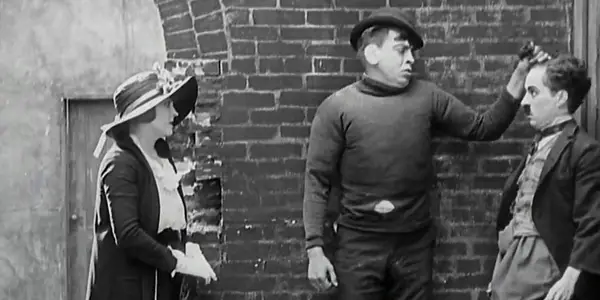
We see this in Chaplin’s masterpiece The Kid (1921), when the Tramp finds himself challenged to a fight by a much taller, buffer man – “a Bully,” according to IMBD. It is clear that the Tramp doesn’t stand a chance, and though he tries his best to flee from the Bully, he does end up getting somewhat roughed up by him. Yet what is most intriguing about this scene is that it is the Woman – a wealthy actress played by Edna Purviance – who breaks up the fight, saving the Tramp and even scolding him afterward. It’s somewhat surreal, how easily she is able to diffuse the fight, but within the logic of the film, it coincides with her status as a wealthy professional woman, having enough power to influence the world around her. In many ways, the Woman is a New Woman, or at the very least the product of the Progressive Era.
She isn’t tall though – Edna Purviance was only 5’2” (158 cm), suitably shorter than the Tramp at 5’5”. Yet her status as a wealthy professional woman is what elevates her high above the Tramp (whether or not that would have been absolutely true in reality). This is not a progressive reversal of gender roles, nor is it praise of female professional success. Rather, it is a means of further denigrating the Tramp in a way that a male bully cannot, because she is a woman and he is a man.
But why would Chaplin and Keaton emasculate themselves in their own movies? Haskell says that it’s so that their characters are up against more, especially in the pursuit of women. Their challenge is greater, as they must compensate for their size, poverty, and weakness with their wit, guile, and heart.
But I’d say the biggest reason is that it’s funny, or at least it’s supposed to be. It’s funny when the Blind Girl in Chaplin’s City Lights (1931) mistakenly believes the Tramp is a wealthy man. It’s funny in Keaton’s Steamboat Bill Jr. (1928) when the big, buff father is shocked to discover that his long-lost son (Keaton) is small and dandy-ish, wearing a beret and playing a ukulele for a crying baby.
Keaton and Chaplin never shied away from making themselves the butt of the joke – it was the basis of a lot of their comedy. Something about them failing to meet the expectations of masculinity is still very funny to us, which says a lot about what we think of men who are not tall, or strong, or well-to-do.
Bringing the Trope to the Silver Screen
Let’s talk some more about Buster Keaton. Although not a tramp, his film persona also bore crucial similarities to the Funny Little Man: short; small; and weak; bumbling and a bit childish. Importantly, it was Keaton who actually employed the Tiny Guy, Huge Girl trope. Parlor, Bedroom and Bath (1931) is a notorious example, and My Wife’s Relations (1922) also sort of counts, but I’d like to focus on Three Ages (1923), which includes a great, sharp example of the trope.
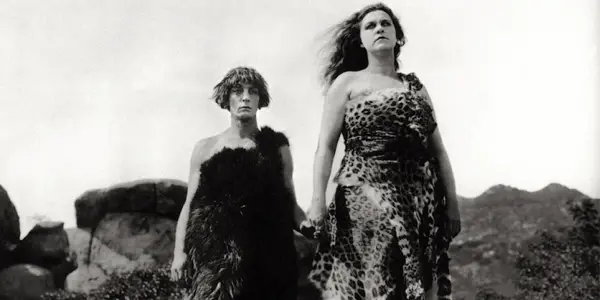
Three Ages (1923) is Buster Keaton’s parody of D.W. Griffith’s masterpiece Intolerance (1916). Like Intolerance, Three Ages tells multiple, parallel stories set in different time periods. In the prehistoric/cavemen story, there is a part where Keaton’s character (“The Boy”) attempts to make his love interest (“The Girl”) jealous by flirting with another woman. The Boy lies down next to this woman on top of a huge boulder. He tries to entice her by banging on his chest, but she is clearly disinterested. Next, we see the Boy’s rival, the Villain, grab the Girl by the hair and drag her into his cave in the most brutish, caveman-like fashion. The Boy decides to copy the Villain and grabs the woman he’s with by the hair.
Here comes the punch line: the woman stands up, revealing that she is a huge Amazon. Played by Blanche Payson, who stood at a whopping 6’2” (188 cm), the comparison between her and Keaton is stunning – he looks absolutely tiny next to her. Worse yet, she’s angry. Much like the New Woman/Tiny Man illustrations of the 1910s, her huge size makes her a physical threat to him, which itself is part of the joke – after all, how inadequate must a man be for him to be threatened by a woman? The Amazon makes good on that threat too: in retaliation for pulling her hair, she knocks the Boy off the boulder with a club, sending him down into a pool of water.
While this whole scene is meant to be comedic, it also raises an interesting question: if women were bigger and stronger than men, would men think first before sexually harassing, assaulting, or otherwise abusing women?
A Really, Really Huge Girl
Let’s jump ahead to the 1950s. This decade is infamous for its conservatism regarding gender roles, with an emphasis on women’s domestic obligation to the family. It was also the era of a lot of great sci-fi films. Attack of the 50 Foot Woman (1958) is not one of them. Nevertheless, the film says some interesting things about gender in the 50s.
The film tells the story of a wealthy, mentally ill alcoholic named Nancy Archer, who has had a close encounter with a giant alien in the desert. When she goes back to the desert to prove what she saw to her skeptical husband Harry (who is cheating on her, by the way), Nancy is captured by the alien. Harry flees back to town, alone. Later, Nancy reappears and ends up growing into a giant herself, stampeding through the town in search of her husband.
If there’s ever been an example of the Tiny Guy, Huge Girl trope, it must be this one, even though it’s not intended to be funny. The “Huge Girl” in this case is kaiju-level huge, an abomination of nature wreaking havoc upon civilization. Like the Amazon in Three Ages, Nancy is also after revenge, which is fair, considering her husband has treated her pretty terribly, cheating on her and even attempting to murder her.
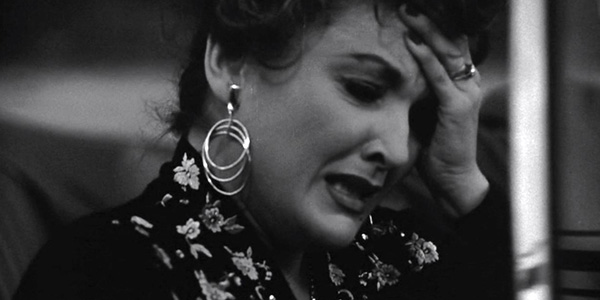
But even before Nancy becomes a giant, she is characterized as a monstrous, mess of a person, an unhinged, migraine-ridden hysteric. Her female nature is so out of control that she must be subdued with bed rest and sedatives. She cannot comply with the proper female role of her era: she is mentally ill; an alcoholic; moody; childless; and belittling towards her husband. Nancy Archer is the absolute antithesis of June Cleaver. So in the end, it’s not surprising that Nancy transforms into a giant, unstoppable monster – it’s the visual manifestation of a non-compliant, domineering woman, whose victim is the poor little man.
A Further Means of Emasculation
Three decades after the 50s, in the early 1980s, the Second Wave of Feminism was reaching its end. Over the past twenty years, it had radically improved women’s lives in a number of measurable ways. Feminist film theory had also emerged as women began to examine movies through the lens of feminist theory. These women came to realize how very male-dominated Hollywood was (and still is), both on screen and behind the scenes.
Most of the early 80s teen movies focused on boys, so there’s something special about John Hughes’ directorial debut Sixteen Candles (1984), which stars Molly Ringwald as a teenage girl whose family forgets about her birthday. In a recent piece for The New Yorker, Ringwald herself says, “No one in Hollywood was writing about the minutiae of high school, and certainly not from a female point of view.”
Yet, despite the film’s sincere portrayal of a teenaged girl, Sixteen Candles came at a time before the advent of political correctness in the late 80s and thus includes a racist caricature that would never fly today, that of Long Duk Dong, the Asian exchange student played by Gedde Watanabe. His poor, awkward English is used as a source of ridicule; he’s inappropriately sexual with no understanding of social norms; and the sound of a gong accompanies his every appearance. The character is flagrantly racist, not a far cry from Mr. Yunioshi in Breakfast at Tiffany’s (1961).
Long Duk Dong’s girlfriend, known only as “Lumberjack” (Debbie Pollack), is an athlete and a full head taller than him. Like Long Duk Dong himself, this pairing is meant to be ridiculous, absurd, and comedic; it is a classic example of the Tiny Guy, Huge Girl trope. The trope always relies upon feminizing the male, but in this case, it must be noted that it feminizes an Asian man specifically. In American media and culture, there is a long history of portraying Asian and Asian-American men as small, weak, nerdy, and foreign – overly feminine and not at all masculine.
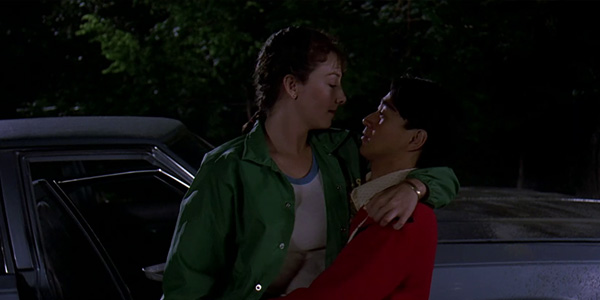
That is definitely part of the humor with Long Duk Dong and Lumberjack’s relationship, making this instance of the Tiny Guy, Huge Girl trope a device of racism more than anything else. Unlike the way Chaplin and Keaton used the trope to make fun of themselves, in Sixteen Candles, John Hughes uses the Tiny Guy, Huge Girl trope as a racist means of emasculating Long Duk Dong. It’s a terrible blight on an otherwise good movie.
Turning the Tide
Ideally, the Tiny Guy, Huge Girl trope should not be funny at all. It only holds the weight because it is literally social deviance – it violates the male-taller norm in heterosexual relationships. From a feminist perspective, this norm is difficult to justify, as it relies upon gendered ideals that the man must be big and strong and ‘protective,’ while the woman must at least be shorter, if not outright petite. Violating this norm means violating the entire structure of masculine-feminine difference that heterosexuality relies and thrives upon. And not too many dare to violate it: a 2008 study of 382 undergraduate students found that just 23% of men surveyed would date a woman taller than them, and only 4% of women would date a man shorter than them.
But social deviance actually serves a number of important functions in society, according to French sociologist Émile Durkheim. For one, social deviance can bring to light new morals and values by pushing up against dominant society’s norms. Think of Rosa Parks’ refusal to give up her seat on the bus to a white person. So if more couples broke the male-taller norm, could the norm be weakened and re-examined, such that those who break it would not be subjected to mockery and ridicule?
Film may finally be turning around and helping pave the way. One of the biggest and most popular film series of the past decade starred a heroine that was at least two inches taller than her male partner and love interest – The Hunger Games. The series’ female protagonist Katniss Everdeen (Jennifer Lawrence) stands at 5’9” (175 cm), making her a bit taller than Peeta Mellark (Josh Hutcherson), who is 5’7” (170 cm). This is especially interesting because in the books, Katniss is often described as small, whereas Peeta is described as significantly taller than her and “stocky.”
Did the film adaptation decide to go one step further with dismantling gender roles, or was the height difference incidental? It’s hard to say. Notably, however, Katniss and Peeta’s height difference is almost never perceptible in the film. Usually they appear about the same height, possibly due to intentional manipulation, for example, during the Tribute Parade in The Hunger Games: Catching Fire (2013). Maybe a discernible height difference would have been too much on top of Peeta’s penchant for baking, painting, and needing to be rescued.

Even so, Katniss and Peeta appearing about the same height still breaks the male-taller norm, so it’s a step in the right direction. Furthermore, their relationship is portrayed as normal, never deviant, ridiculous, or weird, like the Tiny Guy, Huge Girl trope usually is. Hopefully, the success of The Hunger Games demonstrates that an on-screen relationship need not adhere to the male-taller norm – nor gender roles in general – in order to resonate with audiences.
“Tiny Guy, Huge Girl” Trope: Conclusion
The pendulum does indeed seem to be beginning to swing in the opposite direction. A slow start is to be expected though, considering the long history of the Tiny Guy, Huge Girl trope being portrayed as a ridiculous thing, along with people’s strong preferences for maintaining the male-taller norm. But if more media were made that subverted the norm without making it a joke, then that could help nullify the male-taller norm, such that one day, it would be unremarkable – even if uncommon – for the woman to be taller in a heterosexual relationship.
What is your opinion on the Huge Girl, Tiny Guy trope? Have you seen it in other media or films I didn’t mention? Do you think there’s a relationship between the trope and the male-taller social norm in heterosexual relationships? Leave a comment below with your thoughts!
Does content like this matter to you?
Become a Member and support film journalism. Unlock access to all of Film Inquiry`s great articles. Join a community of like-minded readers who are passionate about cinema - get access to our private members Network, give back to independent filmmakers, and more.
Madeline Hrabik is a writer, film buff, and amateur historian from Pittsburgh, Pennsylvania. She is particularly interested in silent film, historical films, and the Golden Age of Mexican Cinema.












